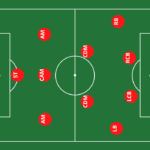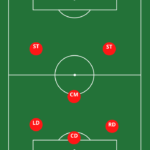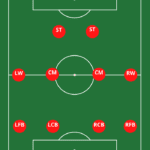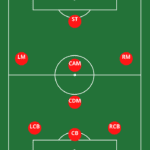- Last Updated -
Introduction – Brief explanation of the term “cap” in soccer.
If you’re a soccer fan, you’ve probably heard the term “cap” being thrown around. But what does it mean exactly?
In short, a cap is a term used to describe the number of times a player has represented their national team in an international match. It’s like a badge of honor that shows how much a player has contributed to their country’s soccer program.
The origin of the term “cap” can be traced back to the early days of soccer in the 19th century. At that time, teams would often wear different colored caps during matches to distinguish themselves from each other and help referees identify players.
According to some sources, players who were capped would receive one of these caps as a commemorative gift. Today, however, receiving a cap is much more significant than simply getting a hat with your team’s logo on it.
In fact, earning your first cap can be one of the most memorable moments in any soccer player’s career. It means you’ve been recognized as one of the best players in your country and have earned the right to represent it on the international stage.
Origin of the Term “Cap” in Soccer
The term “cap” in soccer has a fascinating origin story. The word “cap” is derived from an old English tradition where when a player would make their first appearance for the national team, they were given a cap as a symbol of recognition. These caps were not like the ones we’re used to seeing on our heads but rather they were small tokens sewn onto the player’s shirt.
This tradition began way back in 1851 when England played Scotland for the first time. Interestingly enough, it wasn’t until 1899 that these caps became standardized and distributed to national players across all countries.
This was due to the fact that various teams had different ways of recognizing their national players, such as badges or medals. As time progressed, more and more countries adopted this tradition and soon it became customary for players to receive caps for every international match they played in.
By the early 20th century, having a high cap count in soccer was seen as a significant achievement and an indicator of one’s talent and dedication to the sport. Although caps are synonymous with soccer today, other sports have adopted this concept too.
Rugby also has a cap system where players receive caps for playing on their country’s national team. However, unlike soccer where receiving caps is relatively common, rugby players may only accrue one or two caps throughout their entire career due to fewer international matches being played compared to soccer.
Overall, the term “cap” in soccer has an intriguing history behind it that speaks volumes about its significance not only within soccer but across various sports too. With Ronaldo’s cap count reaching an astonishing 184 in recent years, it’s evident that receiving caps remains a prestigious achievement among international players today.

Meaning of a Cap in Soccer
In soccer, a “cap” is a term used to describe the number of times a player has represented their national team in an international match. A player earns a cap every time they play in an international game for their country, whether it’s a friendly or competitive match. The term “cap” is believed to have originated from the practice of awarding players with a cap or hat after their first international game.
The meaning of a cap in soccer goes beyond just keeping track of how many times someone has played for their national team. It’s also seen as a significant honor and achievement for players to earn as many caps as possible.
Some players make it their goal to reach 100 caps, which is considered an incredible feat and demonstrates longevity and dedication to their country’s team. The idea of earning caps isn’t unique to soccer – it is also used in other sports such as rugby.
However, the term “cap” seems to be specifically associated with soccer. The cap count can also signify seniority within the team; players who have earned more caps are often considered more experienced and respected within the squad.
Some notable records related to caps in soccer include Ronaldo’s impressive cap count at 164, making him one of the most capped players ever. There are also debates around whether or not goals scored during matches should be counted towards cap totals – some countries do include these goals while others do not.
Overall, earning a cap for your national team is seen as one of the highest achievements for any soccer player. It represents not only skill but also commitment and loyalty to your country’s team and fans.
The Significance of a Cap in Soccer
A cap in soccer is a significant achievement for any player. It represents the number of times a player has represented their national team in an international match. Most caps in soccer are earned through years of hard work, dedication, and skill.
A player’s cap count is a measure of their success on the international stage and is often seen as one of the most prestigious accomplishments in soccer. can be seen in the pride players have when representing their country.
It’s an honor to be selected to play for your nation, and earning your first cap is a special moment that will stay with you forever. Every time a player pulls on their national team jersey, they do so with immense pride, knowing that they are representing their country at the highest level.
For some players, reaching 100 caps soccer meaning is the ultimate goal. This milestone achievement signifies long-term success on the international stage and places them amongst an elite group of players who have represented their country with distinction over many years.
Ronaldo’s cap count, for example, stands at 180 caps for Portugal; this record-breaking achievement emphasizes his exceptional talent and dedication to his team. The significance of a cap in soccer cannot be overstated.
It represents not only an individual’s ability but also their commitment to representing their country at the highest level possible. While there are variations such as Cap in rugby or Salary cap in football when it comes to international play getting capped by your national team signifies something special about your abilities as a player within your own nation’s ecosystem of skilled players.

Caps in International Soccer
Most caps in soccer are earned by players who compete at the international level. This means that they represent their country’s national team in official matches, such as the World Cup or European Championship.
The number of caps a player earns is often seen as a reflection of their skill and dedication to the sport. An international cap in soccer is awarded to a player each time they participate in an official match for their national team.
This includes friendlies, qualifiers, and major tournaments like the World Cup. Some players make it their goal to earn as many caps as possible, while others focus on winning trophies with their country.
Ronaldo’s cap count is one of the most impressive in modern soccer history. As of 2021, he has earned over 170 caps for Portugal’s national team and shows no signs of slowing down anytime soon.
His commitment to his country’s team has helped him become one of the most successful and respected players in the sport. Earning an international cap in soccer is a significant achievement for any player.
It represents not only skill but also loyalty and dedication to one’s country and teammates. Whether it be Ronaldo’s impressive cap count or any other player striving towards this goal, representing a nation through soccer is truly an honor that should be cherished by all who achieve it.
Caps in Men’s and Women’s Soccer
Caps, which are considered a significant achievement in soccer, exist for both men and women. However, the way they are awarded differs slightly between the two groups.
In men’s soccer, caps are given for every appearance made by a player in an international match representing their country. This means that each time a player participates in an international game with the national team, they get one cap added to their total number of caps earned.
In women’s soccer, on the other hand, there is a slight variation in how caps are awarded. Women’s teams often play fewer games than men’s teams do; this means that it would be unfair to count every appearance as one cap.
To address this issue, women’s soccer associations have developed an alternative system that grants players one cap per year representing their nation. Some of the greatest soccer legends have achieved incredible cap counts throughout their careers.
Ronaldo (Brazilian) is regarded as one of the all-time greats and has accumulated 98 caps during his career playing for Brazil’s national team. As for women’s footballers who hold records when it comes to capping include American Kristine Lilly who has represented her country 354 times while Japan’s Homare Sawa has played 205 games.
Whether you’re talking about men’s or women’s soccer or any sport where ‘caps’ exist as part of its history and tradition; being capped represents a significant accomplishment in any athlete’s life. The value of representing your nation at an international level cannot be overstated and earning your first cap is something that stays with you forever- no matter how many caps you go on to earn over your career!

Conclusion – Recap of the meaning, origin, and significance of a cap in soccer.
A cap in soccer is an honor given to a player who represents their country at the international level. The term “cap” originated from the practice of giving players a cap with their national team’s emblem on it as a symbol of their accomplishment.
The significance of earning a cap in soccer cannot be overstated. It not only represents the player’s talent and dedication, but it also serves as recognition of their contribution to their country’s soccer history.
The International cap in soccer is highly valued among players worldwide, and achieving 100 caps holds great importance. Some players have even gone on to earn multiple caps throughout their careers and become record holders for the most caps in soccer.
Ronaldo has an impressive cap count that speaks volumes about his career achievements and dedication to representing his country at the international level. It is worth noting that caps are not exclusive to men’s soccer only; women’s soccer also follows this tradition and honors its players with caps for representing their respective countries at the highest levels of competition.
In addition, while “cap” is traditionally associated with soccer, it is also used in other sports such as rugby where it has similar connotations. Overall, earning a cap in soccer signifies one’s excellence in representing one’s nation on an international stage and holds great significance within both men’s and women’s teams.
It remains one of the most prestigious achievements for any footballer or coach alike regardless of whether they play professionally or otherwise. That said, it remains important for football leagues globally to remain conscious of issues around salary cap management given recent upheavals across different football leagues due to financial mismanagement issues arising from lackadaisical enforcement or abuse by certain clubs/teams/staffs/etc..
Final thoughts on the role of caps in the sport of soccer.
Ultimately, the role of caps in soccer is to recognize and reward the incredible achievement of representing one’s country on the international stage. Most caps in soccer are earned through years of dedication and hard work, and the honor of wearing a cap on your national team is not something that should be taken lightly.
Cap counts in soccer are a measure of both talent and commitment, and players like Cristiano Ronaldo have earned respect from fans all over the world for their impressive cap counts. Cap counts aside, international caps in soccer hold a special place in the hearts of fans worldwide.
Watching your favorite players compete on such a grand stage is an experience like no other, and it’s a testament to the hard work and dedication of everyone involved in making these games happen. Of course, there are other types of caps in sports as well – for example, some may be familiar with cap rugby or salary cap football.
But when it comes to soccer specifically, there’s something truly unique about earning an international cap that can’t be replicated by any other type of award or recognition. So if you’re ever lucky enough to earn a cap on your national team…cherish it!
It’s an incredible achievement that only a select few players will ever experience firsthand. And for those who don’t make it quite that far…there’s always next season!
What is the hardest position in soccer to play?
What is The Hardest Position in Soccer Importance of understanding positions in...
Read MoreWhat is a Soccer Assist?
The Importance of Teamwork in Soccer The importance of teamwork in soccer...
Read MoreBest Goalkeeper Gloves 2024
What are the best goalkeeper gloves? When it comes to soccer equipment,...
Read MoreUnderstanding the 4-5-1 Soccer Formation
The Importance of Understanding the Formation Soccer is a tactical sport, and...
Read MoreWhat is the best soccer position to play?
What is the best soccer position? Soccer is a sport that requires...
Read MoreWhat is Soccer Relegation?
Introduction: Exploring the World of Soccer relegation Soccer is one of the...
Read MoreWhat is a cap in soccer?
If you're a soccer fan, you've probably heard the term "cap" being...
Read MoreSoccer vs Football Field – A Tale of Two Fields
Comparing the Corners: Soccer Field Vs Football Field Shapes Let's talk a...
Read MoreBest Indoor Soccer Shoes 2024
Indoor soccer has been gaining popularity over the years, with more and...
Read MoreHandball Rule In Soccer – Law #12
Soccer is one of the most popular sports globally, with millions of...
Read Moresoccer position numbers quick guide
Each player on the field has an important job as it relates...
Read MoreSoccer Substitution Rules: The Strategic Art of Changing the Game
Soccer, known as the beautiful game worldwide, has seen various changes to...
Read MoreDominate the Field With The 4-2-3-1 Soccer Formation
Soccer is a dynamic game that constantly evolves, and its tactics are...
Read MoreSoccer History USA: From Struggles to Successes
Soccer, also known as football, is the world's most popular sport, with...
Read More5-3-2 Soccer Formation: History and Tactics
Are you a soccer enthusiast looking to understand the tactical intricacies that...
Read MoreSoccer Overtime Rules: Everything You Need to Know
Introduction: Overtime Soccer Rules Everything You Need To Know Soccer is a...
Read MoreMastering Soccer Outside Back Position: Tips and Techniques
Soccer is a dynamic sport, and the outside back position is no...
Read MoreThe Mercy Rule In Soccer And The Roll It Plays
Picture this: a soccer match, with one team dominating the field and...
Read MoreSoccer Position Abbreviations – A Beginners Guide
Hey there! You've landed on "Decoding Soccer Positions: A Rookie's Handbook". This...
Read MoreBest Soccer Cleats for Flat Feet 2024
Unlock your soccer potential and tap into the game-changing secret: the ultimate...
Read MoreBest Youth Soccer Cleats for 2024 : Top 5 Pick
Welcome to our comprehensive guide on the best youth soccer cleats for...
Read MoreBox-to-Box Center Midfielder: The Engine of Modern Soccer Teams
Soccer is a game of skill, strategy, and teamwork. Every player has...
Read MoreBest Soccer Cleat Insoles 2024
What are the Best Insoles For Soccer Cleat? Are you a serious...
Read MoreBest Soccer Cleats for Turf 2024
What are the Best Soccer Cleats for Turf Fields? Look no further...
Read MoreSoccer’s Attacking Midfielder And The Crucial Role It Plays
The attacking midfielder position in soccer is a vital role that requires...
Read MoreBreaking Down the False 9 Soccer Position
The false 9 position is a term used in soccer to describe...
Read MoreThe Sweeper Soccer Position: A Versatile and Dynamic Role
The sweeper position was popularized in the 1960s and 70s by the...
Read MoreThe Role of a Center Defensive Midfielder
The Backbone of the Team: The Role of a Center Defensive Midfielder...
Read MoreSoccer Halftime: How Long Is It?
Halftime in FIFA and MLS matches is a fixed duration of 15...
Read MoreBest Grip Socks For Soccer 2025
In this post, we present the best grip socks for soccer, so...
Read MoreSoccer Corner Kick – Soccer Law #17
A corner kick is a type of free-kick that is awarded to...
Read MoreSoccer Yellow Card … What Does It Mean?
Yellow cards are used to maintain order and fairness on the soccer...
Read MoreUnderstanding the Six Soccer Defensive Positions
In this article, focused on six defensive positions: goalkeeper (GK), sweeper (SW),...
Read MoreThe Highest Scoring Games In Soccer History
Phew, after reading about the seven worst blowouts in soccer history, I...
Read MoreThe Power of a Goal in Soccer, How it Influences The Game
Football, commonly known as soccer, has established itself as a globally renowned...
Read MoreMastering the 4-3-3 Soccer Formation
Here Are Some Teams That Have Mastered the 4-3-3 Soccer Formation -...
Read More7v7 Soccer Formations
Choosing the right 7v7 soccer formation is crucial for success on the...
Read MoreMastering the 4-4-2 Soccer Formation
The 4-4-2 soccer formation is one of the most popular formations used...
Read MoreCan Soccer Cleats Be Used For Baseball?… Pros and Cons…
Soccer and baseball are two different sports that require specific types of...
Read MoreUS Youth Soccer: Everything You Need to Know
US Youth Soccer (USYS) is the largest youth sports organization in the...
Read MoreBest Soccer Backpacks 2024
Soccer demands that you carry gear, such as balls, cleats, uniforms, water...
Read MoreHow Many Soccer Players Are On A Field?
The standard number of players on a soccer team is eleven. Each...
Read MoreAll About Soccer – Almost Everything You Need To Know
What Is Soccer? Soccer, also known as Association Football, is a popular...
Read MoreUnderstanding the Offside Rule in Soccer
Soccer, also known as football, is one of the most popular sports...
Read MoreSoccer Goalie Rules: Understanding the Goalkeeper Position
As soccer players try to gain control of the game, midfielders are...
Read MoreChoosing the Right Soccer Ball Size by Age
Soccer is undeniably one of the most popular sports in the world,...
Read More7 Tips To Becoming A Great Soccer Striker
A great soccer striker is a player who has the ability to...
Read MoreBest Soccer Cleats For Defenders 2024
What are the Best Soccer Cleats for Defenders? In our opinion, the...
Read MoreBest Soccer Cleats For Wide Feet 2024
The world of soccer is vast, and players come in all shapes...
Read MoreHow Many Soccer Games In A Season
The number of soccer games in a season varies depending on the...
Read MoreThe Ultimate Guide to Soccer Field Size
How big is a soccer field? Read this post and get a...
Read MoreSoccer Position # 9 Center Forward Explained
Playing the # 9 soccer position, forward or Striker, is a crucial...
Read MoreSoccer Position # 4 Center Back Explained
Center Back in soccer is the # 4 Position, also known as...
Read MoreBest Adidas Soccer Cleats – Top 5 Picks
choosing the right type of soccer cleat is essential for optimal performance...
Read MoreThe Essential Soccer Skills Every Player Needs
From ball control to positioning, there are numerous technical aspects that every...
Read MoreMastering the Midfield Is The Key To Winning In Soccer
As soccer players try to gain control of the game, midfielders are...
Read More9v9 Soccer Positions Explained
9v9 soccer, also known as small-sided soccer, is a variation of the...
Read MoreTwo Soccer Skills That Are Essential
Shooting and Heading the soccer ball are both soccer skills you should...
Read More





















































